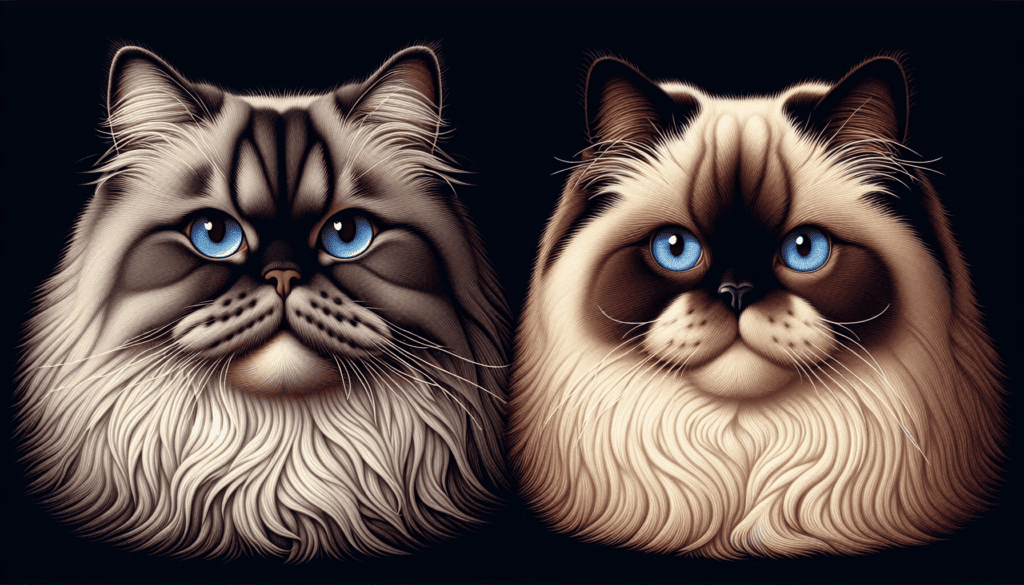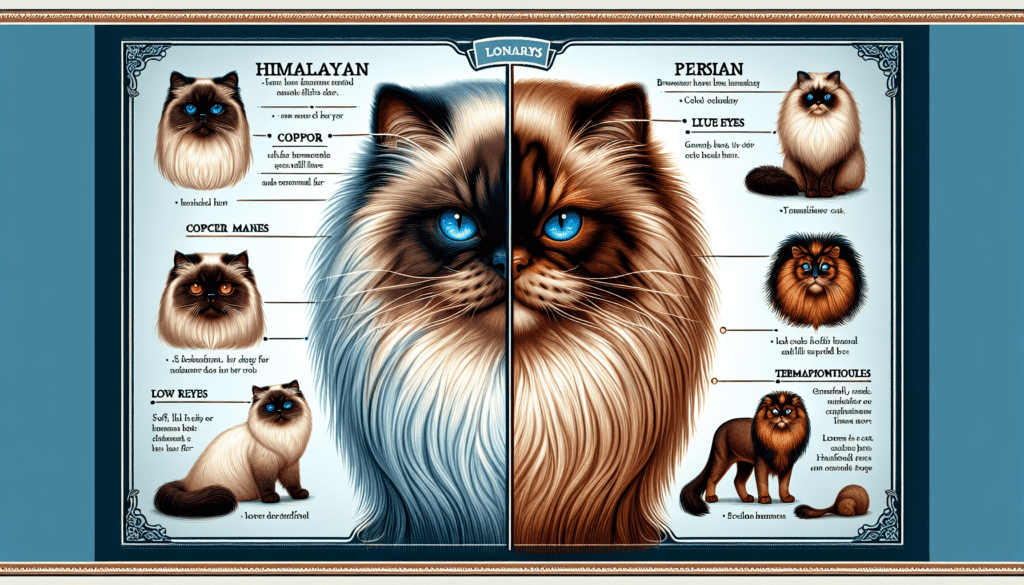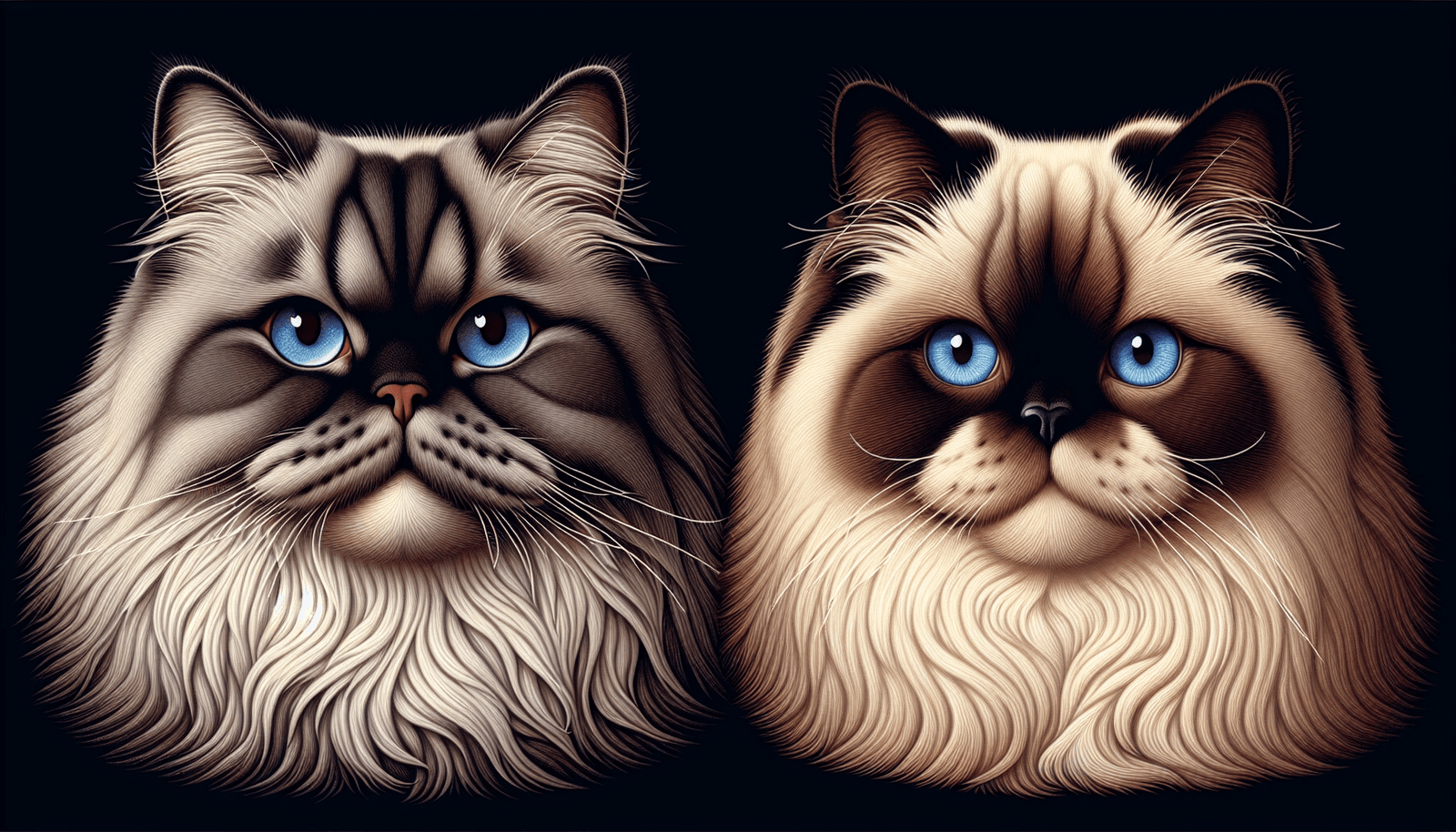Are you curious about the difference between a Himalayan cat and a Persian cat? While they may look similar, there are some distinct characteristics that set them apart. Although both breeds have luxurious, long fur and adorable, round faces, the Himalayan cat is actually a crossbreed of the Persian and Siamese cats. This combination results in a stunning feline with the coat patterns of a Persian and the striking blue eyes of a Siamese. So, if you’ve ever wondered if a Himalayan cat is the same as a Persian, the answer is no, but they do share some similarities that make them equally captivating.

Physical Appearance
Coat Length
Both Persian and Himalayan cats have long, luxurious coats that are incredibly soft to the touch. Their fur is dense and thick, making them look incredibly fluffy and huggable. This beautiful feature is one that both breeds are well-known for, and it adds to their overall charm and elegance.
Coat Color
When it comes to coat color, both Persian and Himalayan cats exhibit a wide range of possibilities. However, there is a distinction between the two. While Persians come in an array of solid colors, including black, white, blue, cream, and silver, Himalayans are famous for their color-point patterns. These patterns resemble those seen in Siamese cats, featuring a lighter body color with darker coloration on the extremities, such as the ears, paws, and tail.
Body Structure
Both Persian and Himalayan cats share a similar body structure, characterized by a compact and sturdy build. These cats have a round face, short legs, and a stocky appearance. Their bodies are medium to large in size, giving them a charmingly chubby and cuddly appearance. This unique body structure contributes to their adorable and endearing personalities.
Facial Features
Nose
The Persian and Himalayan cats both have short, broad noses. These flat-faced felines possess a distinctive facial structure known as brachycephalic, which is a defining characteristic of the Persian breed. This gives them a cute and ‘smushed’ appearance that is adored by cat lovers worldwide.
Eyes
One trait that significantly captures attention in both Persian and Himalayan cats is their strikingly beautiful eyes. These cats have large, round eyes that are full of expression. The eye color can vary, ranging from shades of blue to green and amber. Their eyes exude a sense of deep warmth and intelligence, perfectly complementing their sweet and gentle nature.
Head Shape
The head shape of both Persian and Himalayan cats is one of their distinguishing features. They have a round, wide skull and a well-rounded face. This unique head shape is often attributed to the Persian genealogy, as Himalayans are a result of crossbreeding Persians with Siamese cats. The charmingly rounded face simply adds to their irresistible cuteness.
Personality Traits
Temperament
Persian and Himalayan cats share similar personality traits that make them wonderful companions. They are known for their calm, gentle, and sweet nature. These cats thrive in peaceful environments and prefer a relaxed and predictable routine. They are generally reserved and prefer to observe their surroundings rather than engage in active play or exploration. Persian and Himalayan cats are well-suited for individuals or families that appreciate a calm, serene pet that brings tranquility to the household.
Activity Level
Due to their easygoing nature, Persian and Himalayan cats have a relatively low activity level. They are not known for their athleticism and tend to be more content lounging on a cozy spot or snuggling up with their humans. While they may not be as energetic as some other breeds, they do enjoy gentle play and interactive toys that provide mental stimulation. These cats are perfect for those who prefer a more relaxed and laid-back companion.
Social Behavior
Both Persian and Himalayan cats are highly social animals that thrive on companionship. They bond deeply with their owners and enjoy being a part of the family. These cats love to spend quality time with their humans, whether it’s lounging together or receiving gentle pets and attention. While they are generally reserved around strangers, they are not known to be aggressive or shy. Persian and Himalayan cats have a natural inclination towards peaceful coexistence and make great additions to households with a calm and harmonious atmosphere.
Grooming Needs
Coat Care
One aspect that potential owners need to consider when welcoming a Persian or Himalayan cat into their lives is the grooming needs associated with their long coats. Regular grooming is essential for maintaining the health and beauty of their fur. These cats require daily brushing to prevent matting and tangling of their hair. Additionally, periodic baths are recommended to keep their coats clean and free of dirt or oils. Grooming sessions also provide an opportunity for bonding and strengthening the bond between the owner and their feline companion.
Eye Care
Persian and Himalayan cats are prone to eye-related issues due to their prominent and often protruding eyes. These precious felines require special attention to their eyes to ensure optimal health. Owners should clean their cat’s eyes daily, using a soft, damp cloth to remove any discharge or debris that may accumulate. Regular eye examinations by a veterinarian are also crucial to detect any potential issues and provide appropriate care.
Hygiene
Due to their brachycephalic facial structure, Persian and Himalayan cats may require special attention to their hygiene. Their facial folds can harbor dirt and moisture, leading to potential skin irritations or infections. Regularly cleaning and drying the folds with a soft cloth can help prevent such issues. Additionally, maintaining proper oral hygiene is essential, as these breeds are prone to dental problems. Regular teeth brushing or providing dental treats can help promote good oral health.

Health Considerations
Genetic Disorders
Both Persian and Himalayan cats can be prone to certain genetic disorders due to their breeding history. Polycystic Kidney Disease (PKD) is one such condition that affects some Persian cats. This inherited disease can cause cysts to form in the kidneys, potentially leading to kidney failure. Responsible breeders will perform genetic testing to ensure that they are not passing on this condition to their kittens.
Breathing Issues
The unique facial structure of Persian and Himalayan cats can also contribute to breathing issues. These breeds may have a tendency for nasal and sinus congestion, snoring, and difficulty breathing in extreme temperatures or stressful situations. Monitoring their respiratory health and providing a comfortable environment is essential to ensure their well-being.
Eye Problems
Persian and Himalayan cats are also prone to various eye problems, including cherry eye, entropion, and corneal ulcers. These cats’ prominent eyes make them more susceptible to certain conditions that can affect their vision. Regular eye checks with a veterinarian can help catch any developing issues early and prevent further complications.
Origins and History
Persian Cat
The Persian cat, known for its regal appearance and enchanting beauty, has a fascinating history that dates back centuries. Its origins trace back to Persia (modern-day Iran) and were introduced to Europe in the seventeenth century. The Persian breed quickly became popular due to its striking looks and serene personality. Over time, breeders selectively bred Persians to enhance specific physical features, resulting in the development of various coat colors and patterns seen in Persians today.
Himalayan Cat
The Himalayan cat is a result of crossbreeding Persians with Siamese cats. The goal was to combine the Persian’s luxurious coat with the Siamese’s captivating color-point patterns. This crossbreeding process resulted in the creation of the Himalayan breed, which shares many characteristics with its Persian ancestors. The Himalayan breed was formally recognized as a separate breed in the 1950s and quickly gained popularity among cat enthusiasts.
Breed Standards and Recognition
Persian Cat Breed Standards
The Persian cat has specific breed standards that define its desired physical traits. These standards include a round head with a broad face, small and round-tipped ears, and large round eyes in various colors. The body should be cobby and muscular, with short, sturdy legs. The Persian breed standards also outline specific coat requirements, with a dense, long, and flowing coat being highly desirable. Numerous cat associations and organizations recognize and uphold these breed standards in Persian cats.
Himalayan Cat Breed Standards
Himalayan cats also have breed standards that define their ideal physical characteristics. These standards highlight the breed’s color-point patterns, consisting of a contrasting body and darker coloration on the extremities. The standards include a round head, distinctive wide-set eyes, and a short, cobby body structure. The Himalayan breed is recognized by various cat associations, and adherence to these breed standards ensures the preservation of the breed’s unique traits.
Breeding and Crossbreeds
Breeding Himalayans
Breeding Himalayan cats involves crossing Persians with Siamese cats to achieve the desired color-point patterns. The breeding process requires careful selection to preserve the breed’s distinctive looks and charming personalities. Responsible breeders adhere to specific guidelines and consider genetic testing to prevent the transmission of inherited diseases. By selecting compatible parents and maintaining high breeding standards, breeders can produce healthy and true-to-type Himalayan kittens.
Persian-Himalayan Crossbreeds
Persian-Himalayan crossbreeds, also known as Exotic Longhairs, are the offspring of Persian and Himalayan parents. These cats combine the Persian’s lovely coat with the striking color-point patterns of the Himalayan. While they may vary in appearance, depending on the specific characteristics inherited from their parents, they typically possess the gentle and placid temperament shared by both breeds. Persian-Himalayan crossbreeds have gained popularity among cat enthusiasts for their unique blend of physical traits.
Popularity and Demand
Popularity of Persian Cats
Persian cats have enjoyed immense popularity for many years, thanks to their stunning appearance and amiable personality. Their luxurious coats and gentle demeanor make them highly sought after by cat lovers worldwide. Persian cats can often be seen gracing homes, cat shows, and social media platforms, captivating audiences with their regal presence and irresistible charm.
Popularity of Himalayan Cats
Himalayan cats, with their striking color-point patterns and appealing personalities, have also gained significant popularity among cat enthusiasts. Their unique look, reminiscent of Siamese cats, combined with the luxurious coat of a Persian, makes them a desirable choice for those seeking a stunning and affectionate feline companion. Himalayans have become a favored breed, admired for their beauty and serene nature.
Price and Availability
Price Range
The price range for Persian and Himalayan cats can vary depending on various factors such as lineage, pedigree, coat quality, and the breeder’s reputation. Show-quality kittens from reputable breeders can command higher prices, typically ranging from several hundred to several thousand dollars. However, pet-quality kittens or older cats that may have minor faults according to breed standards are often more affordable. Potential owners should research breeders, ask for health guarantees, and be prepared to invest financially in providing a loving and appropriate home for their feline companion.
Availability
Persian and Himalayan cats can often be found through reputable breeders who specialize in these breeds. However, due to their popularity, it is important to approach the search with caution and ensure that the breeder follows ethical breeding practices. Additionally, adopting a Persian or Himalayan cat from a rescue or shelter is another option to consider. While these cats may not have a documented pedigree, they can still make wonderful and loving companions, providing a forever home for a deserving cat in need.

